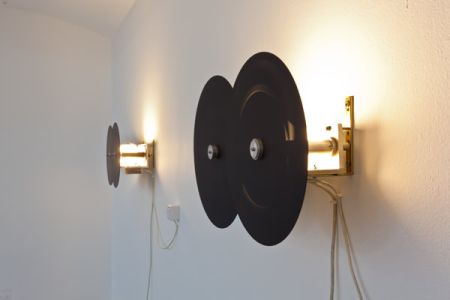ATTILA CSÖRGÕ
Wiener Secession
Friedrichstraße 12 - Wien
2 December, 2011 – 5 February, 2012
The Hungarian artist Attila Csörgõ's photographic, sculptural, and graphical works use humor and irony to introduce the beholder to questions from the natural sciences—with results that are often unexpected and, more importantly, amusing. Csörgõ builds experimental arrangements to explore phenomena from kinetics, optics, or geometry. The artist's oeuvre thus probes questions of human perception and ideas about the construction of the world. By using photography, for instance, to capture the light emitted by motion sequences or energetic processes, Csörgõ enables us to see phenomena that are imperceptible under ordinary conditions, rendering us keenly aware of what we take for granted. The artist builds his apparatuses out of everyday objects and materials. For the sculpture Magnet Spring (1991), for instance, Csörgõ relied on the magic of magnetism. Twelve glass panes were held upright by nothing but the force of repulsion between numerous magnets in the shape of ice hockey pucks that seemed to float. For Moebius Space (2006), the artist developed a mechanism for a tracking shot that enabled him to create a photographic Moebius strip—a loop in which the two ends of a film are still an exact match after a rotation of 180°. At the Secession, Attila Csörgõ will present a new work.
Attila Csörgõ, b. Budapest (HU) 1965, lives and works in Budapest (HU).
Wiener Secession
Friedrichstraße 12 - Wien
2 December, 2011 – 5 February, 2012
The Hungarian artist Attila Csörgõ's photographic, sculptural, and graphical works use humor and irony to introduce the beholder to questions from the natural sciences—with results that are often unexpected and, more importantly, amusing. Csörgõ builds experimental arrangements to explore phenomena from kinetics, optics, or geometry. The artist's oeuvre thus probes questions of human perception and ideas about the construction of the world. By using photography, for instance, to capture the light emitted by motion sequences or energetic processes, Csörgõ enables us to see phenomena that are imperceptible under ordinary conditions, rendering us keenly aware of what we take for granted. The artist builds his apparatuses out of everyday objects and materials. For the sculpture Magnet Spring (1991), for instance, Csörgõ relied on the magic of magnetism. Twelve glass panes were held upright by nothing but the force of repulsion between numerous magnets in the shape of ice hockey pucks that seemed to float. For Moebius Space (2006), the artist developed a mechanism for a tracking shot that enabled him to create a photographic Moebius strip—a loop in which the two ends of a film are still an exact match after a rotation of 180°. At the Secession, Attila Csörgõ will present a new work.
Attila Csörgõ, b. Budapest (HU) 1965, lives and works in Budapest (HU).
